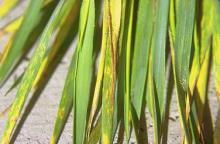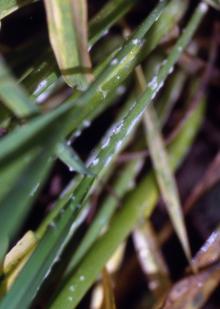Cause The fungus, Blumeria graminis (syn. = Erysiphe graminis). Powdery mildew survives as either chasmothecia or as mycelium. Asexual (conidia) or sexual spores (ascospores formed in the chasmothecia) produced in the spring cause new infections on susceptible hosts. As colonies develop, more conidia are produced and disseminate. The powdery mildew colonies may eventually become spotted with tiny black dots, which are the chasmothecia. High humidity, temperatures ranging from 59°F to 72°F, and succulent growth favor mildew development. When the flag leaf becomes severely diseased by heading, yield losses can reach 50%.
Symptoms Powdery white, gray, or buff-color spore masses develop on leaves, stems, and heads. Distinct dark brown dots may be visible on older lesions. Heavily infected leaves soon yellow, brown, and die.
Cultural control
- Avoid excessive nitrogen fertilization; maintain a balance between potassium and phosphorus proportions.
- Lighter seeding rates reduce stand density, improve air circulation, and reduce the amount of damage.
- Soft red winter wheats are generally resistant.
- Destroying host debris and volunteer wheat can reduce inoculum.
- Rotation with resistant hosts can reduce inoculum.
- 'Foote' has resistance to powdery mildew.
Chemical control Once disease is common on flag leaves before heading, fungicide applications are probably not economical. In areas where powdery mildew has been a problem, scout fields for powdery mildew early in the season and treat fields early if a build-up of disease is apparent before flowering.
Seed treatments reduce seedling infections.
- Dividend Extreme (Group 3 + 4) at 2 to 4 fl oz/100 lb of wheat or triticale seed. Do not graze green forage for 55 days after planting. See label for reentry restrictions.
- Dividend XL RTA (Group 3 + 4) at 10 fl oz/100 lb of winter wheat seed. Do not graze green forage until 55 days after planting. See label for reentry restrictions.
- Raxil MD (Group 3 + 4) at 5 to 6.5 fl oz/100 lb seed plus a dye. See label for reentry restrictions.
Foliar applications may be used under severe disease pressure or when raising a highly susceptible variety.
- Badge SC (Group M1) at 0.5 to 1.8 pints/A on no shorter than 10-day intervals. Preharvest interval is 0 days. 48-hr reentry.
- Bicarbonates are registered to control powdery mildew. Thorough coverage is essential.
- Carb-O-Nator at 2.5 to 5 lb/100 gal of water on 5- to 14-day intervals, depending on disease pressure. Preharvest interval is zero (0) days for all listed crops. 4-hr reentry. O
- Kaligreen at 2.5 to 3 lb/A on 7- to 10-day intervals. May be applied up to the day before harvest. 4-hr reentry. O
- MilStop SP at 2 to 5 lb/A on 7- to 14-day intervals. Can be applied up to and including the day of harvest. 1-hr reentry. O
- Vacres at 2.5 to 5 lb/A on 7- to 14-day intervals. Preharvest interval is zero (0) days. 4-hr reentry.
- Demethylation-inhibiting (DMI) fungicides (Group 3) are labeled for use.
- Alto 100SL at 1.5 to 5.5 fl oz/A applied between Feekes Stage 8 and 10.5.1 Preharvest interval is 21 days forage and hay; 30 for grain and straw. 12-hr reentry.
- Bumper 41.8 EC at 4 fl oz/A. May be applied until Feekes growth stage 10.5. Do not treat within 30 days of harvest for forage or hay. 12-hr reentry.
- PropiMax EC at 4 fl oz/A as a single application per season, no later than the end of flowering (Feekes 10.5). Do not graze or feed treated forage to livestock or harvest treated crop for hay or silage. After harvest, straw may be used for bedding. Do not apply within 40 days of harvest. 12-hr reentry.
- Tebuzol 3.6F at 4 fl oz/A at flag-leaf emergence up to the end of flowering. Do not apply within 30 days of harvest. 12-hr reentry.
- Tilt at 4 oz/A at flag-leaf emergence (Feekes stage 8) but no later than Feekes 10.5. Do not apply within 7 days of harvest for forage or hay. 12-hr reentry.
- Topguard at 10 to 14 fl oz/A on 7-day intervals. Preharvest interval is 0 days for forage, 15 days for hay, and 30 days for grain. 12-hr reentry.
- JMS Stylet-Oil at 1 to 2 pints/A is labeled for use on wheat for other diseases but may aid with powdery mildew. Up to three (3) applications can be made starting when the first node of the stem is visible (Feekes 6) through the end of flowering (Feekes 10.5). Do not spray if foliage is wet or if the temperature is below 32°F, above 90°F or when plants are under heat or moisture stress. 4-hr reentry. O
- Strobilurin fungicides (Group 11) are labeled for use. Do not make more than one (1) application of a Group 11 fungicide before alternating to a labeled fungicide with a different mode of action.
- Aftershock at 2.5 to 4 fl oz/A on 14- to 21- day intervals up to late head emergence (Feekes 10.5). Make no more than one (1) application prior to harvest of wheat forage. Do not apply within 7 days of harvest for forage and hay; 40 days of harvest for grain and straw. 12-hr reentry.
- Headline at 6 to 9 fl oz/A. Do not apply later than the end of flowering (Feekes 10.5). Preharvest interval is 14 days for hay and forage. 12-hr reentry.
- Quadris Flowable at 7.5 to 11 fl oz/A up to late head emergence (Feekes 10.5). Do not apply within 7 days of harvest for forage and hay and 14 days of grazing. 4-hr reentry.
Note: Premixed fungicides are available for use. Do not make more than one (1) application of any Group 11 fungicide before alternating to a labeled fungicide with a different mode of action.
- Dexter Xcel (Group M3 + 11 +3) at 48 fl oz/A. The single application may be applied up to Feekes growth stage 10.54. Preharvest interval is 30 days. 24-hr reentry.
- Miravis Ace (Group 3 + 7) at 13.7 fl oz/A. Apply between Feekes 10.3 and 10.5.4. Harvest interval is 7 days for forage and hay. 12-hr reentry.
- Priaxor (Group 7 + 11) at 4 to 8 oz/A immediately after flag leaf emergence but no later than the beginning of flowering (Feekes 10.5). Preharvest interval is 7 days for forage and chopped feed. 12-hr reentry.
- Quilt Xcel (Group 3 + 11) at 10.5 to 14 fl oz/A when the flag leaf is 50% to fully emerged. Applications may be made no closer than a 14-day interval and may be applied up to Feekes growth stage 10.5. Do not make more than two (2) applications per season. Preharvest interval is 7 days for forage and hay. 12-hr reentry.
- Stratego (Group 3 + 11) at 10 fl oz/A or Stratego YLD at 4 fl/oz/A. Do not apply after flag-leaf emergence (Feekes stage 8). Do not make more than two (2) applications per season. Do not apply within 35 days of harvest. See label for grazing, forage, and hay restrictions. 12-hr reentry.
- Trivapro (Group 3 + 7 + 11) at 9.4 to 13.7 fl oz/A beginning when the flag leaf is 50% to fully emerged, up through full head emergence. Do not make more than two (2) sequential applications of Trivapro or other Group 7 or Group 11 fungicides. Preharvest interval is 7 days for forage and hay, 14 days for grain. 12-hr reentry.



